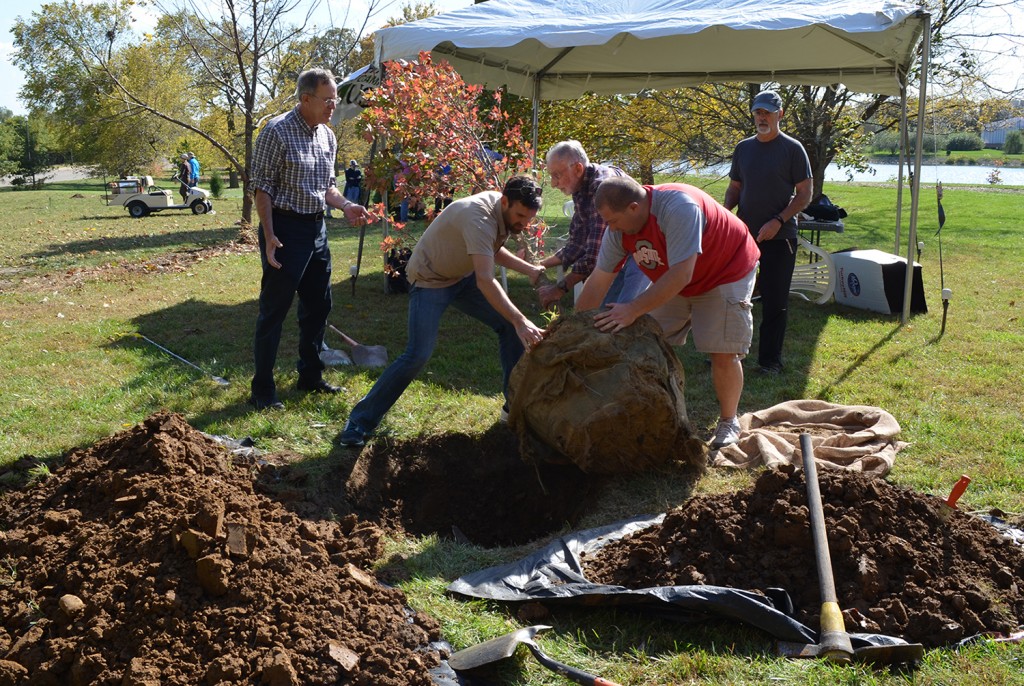
A small group plants a tree at the 2014 ArboBlitz at Chadwick Arboretum North. Credit: Courtesy of Christina Voise
ArboBlitz 2015, an annual service learning project, will provide an opportunity for students and faculty to plant trees on campus this semester to help continue OSU’s certification in Tree Campus USA.
The planting will take place at the east entrance of Kottman Hall on Friday, between 1 and 4 p.m., between 1:00 p.m. and 4:00 p.m. Trees and tools will be provided by Chadwick Arboretum and Learning Gardens, the event host, where tree experts will be on hand to guide students.
OSU first applied for Tree Campus USA certification in 2011, and has been getting certified ever since. The nationwide program is sponsored by the Arbor Day Foundation and recognizes colleges and universities that effectively manage their campus trees and engage students in tree management, according to the College of Food, Agricultural and Environmental Sciences website.
To maintain its Tree Campus USA certification, OSU has to develop ArboBlitz and other campus tree events annually.
The Tree Campus USA certification helps keep a constant focus on campus trees and sustain healthy community forests, said Christina Voise, geographic information systems & accessions specialist of Chadwick Arboretum and Learning Gardens.
“We have beautiful trees on campus today because those who came before us had the foresight to plant them,” Voise said in an email. “We, too, must leave a legacy of trees on the OSU campus and the Tree Campus USA program helps ensure that this happens.”
Voise said that interest in campus trees was heightened in 2010 when two large American sycamore trees near the Medical Center were targeted for removal due to construction. Through the efforts of concerned OSU staff and volunteers, as well as extra effort and expenditures by OSU, the trees were saved.
OSU received its Tree Campus USA certification from the Arbor Day Foundation. and ArboBlitz began in 2011 as a service learning activity required for OSU to maintain certification, Voise said.
The tree-planting event has been going ever since, with this year marking the Fifth Annual ArboBlitz. Past events included campus tree mapping, tree inventory and a tree identification clinic.
“The major achievement is that ArboBlitz has been able to gather students on a weekly basis to go out and map the campus trees,” said Steve Volkmann, OSU’s landscape architect, who is in charge of the annual application process.
“Our past events are very successful,” Volkmann said. “Now we decide to focus on planting more trees, but also teaching proper techniques to the participants this semester.”
Volkmann said that students will learn the proper size and depth of the hole needed for a tree, how to remove containers, burlap or wire caging from a tree’s root ball, how to move a tree into the hole, how to back-fill soil around the tree, and proper mulching and watering.
Students can plant various kinds of trees, including white oak, overcup oak, northern pin oak, willow oak, swamp chestnut oak, American beech and sourwood, and be provided with snacks, drinks and free ArboBlitz T-shirts during the event, said Voise.
Voise said ArboBlitz aims to teach students, staff, faculty and the public about the importance of trees.
“Trees beautify our environment and produce many of the foods we eat, limit runoff of stormwater, help to reduce flooding, shade buildings which helps to reduce cooling costs in summer, and protect buildings from the wind in winter which helps reduce heating costs,” Voise said. “Trees also absorb air pollutants, including carbon dioxide, and so can play an important role in helping OSU to reach its goal of becoming carbon neutral by 2050.”
Planting trees might also help boost tree canopy cover on campus with benefits in the future as the trees grow larger. Voise said the tree canopy has declined in recent years due in part to ongoing construction at OSU, whose canopy cover stands at approximately 11% percent, which is about half of the average canopy for the City of Columbus.
“Tree canopy is easy to lose but hard to rebuild because it takes a long time for a newly planted tree to grow to a size that makes an impact on canopy cover,” Voise said. “This is why it is important to preserve large, old trees.”
Columbus has been a Tree City USA member for 36 years, according to the website of the Arbor Day Foundation. However, at present, Columbus’ tree canopy covers only 22 percent of the city, less than similar cities, according to columbus.gov.
To deal with the problem, Columbus is launching its “Branch Out Columbus” campaign, working with 20 nonprofit groups to plant 300,000 medium-sized trees by the year 2020 and boost the tree cover to 27 percent, said Voise. She added that Chadwick Arboretum is a partner in the effort and has pledged to help the campaign.
“The ongoing tree inventory at OSU, spearheaded by Chadwick, has helped to map and identify over 17,500 trees and shrubs on campus to date, and our past events have gathered many students to help sustain our leafy campus,” Voise said. “ We continues to encourage public and student involvement with our trees, and if you love trees, you will love Chadwick Arboretum.”


